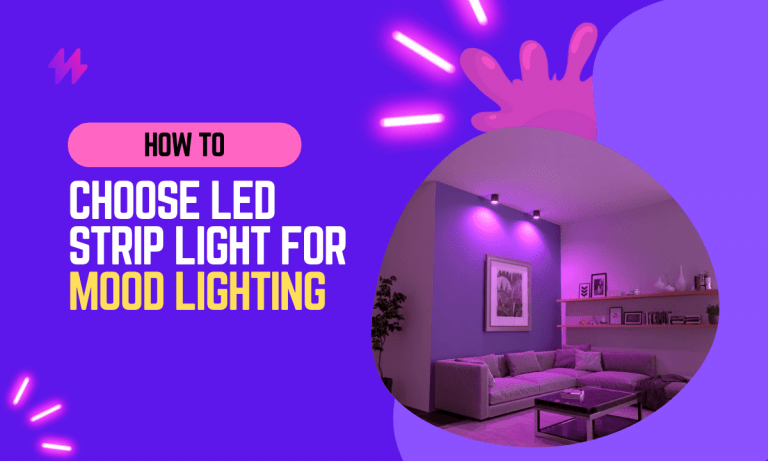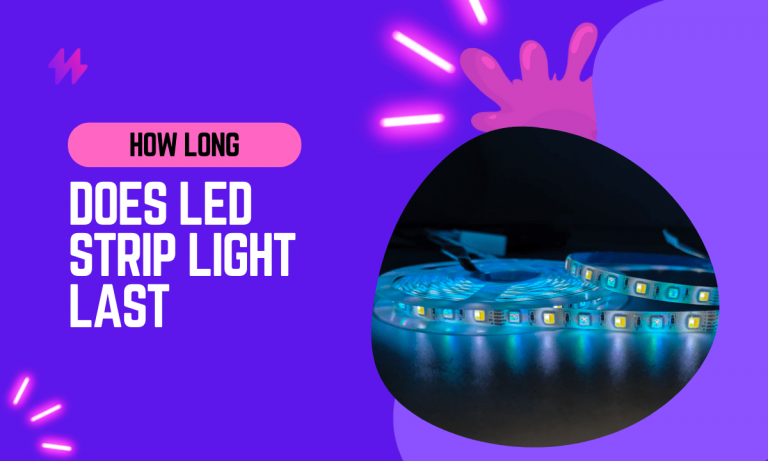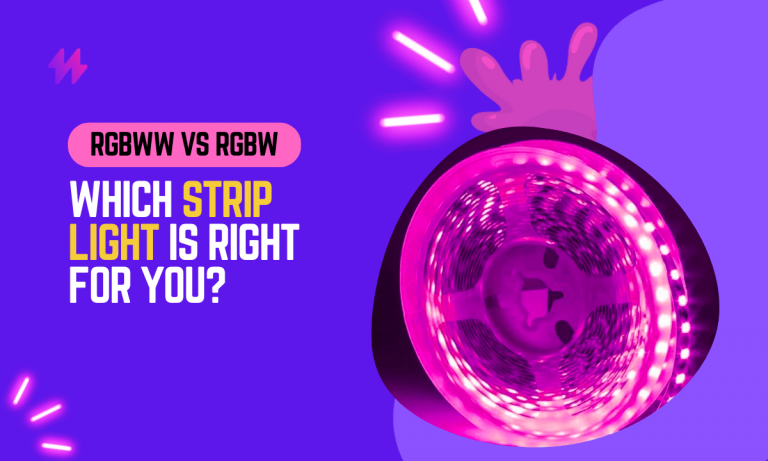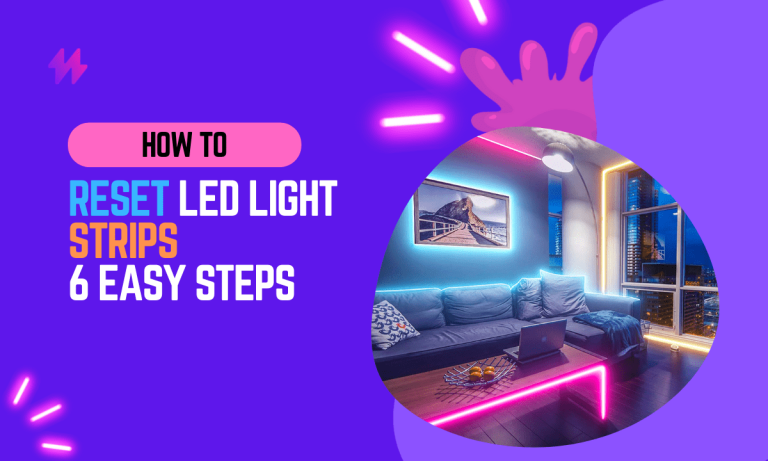How to Power LED Strip Lights with Batteries?
If you’re looking for a way to power your LED strip lights without having to run an extension cord across the room, you’re in luck. In this article, I’ll show you how to power LED strip lights with batteries.
I’m a LED Light Technician with 10 years of experience, and I’ve helped countless people solve this problem. In this article, I’ll share my knowledge with you so that you can power your LED strip lights without any hassle.
So, what are you waiting for? Let’s get started!
To begin powering your LED strip lights with batteries, you’ll want to select suitable batteries based on their capacity and voltage requirements. Consider using rechargeable batteries for a more sustainable option that reduces electricity cost and waste while ensuring your lights stay bright and vibrant.
How to Use Batteries to Power LED Lights: A Comprehensive Guide
LED strip lights are a popular choice for lighting up everything from under-cabinets to home theaters. They’re easy to install, and they come in a variety of colors and brightness levels. But what if you don’t have access to an outlet? Or what if you want to use your LED strip lights in a remote location?
In this article, we’ll show you how to power LED strip lights with batteries. We’ll cover the different types of batteries you can use, how to connect them to your LED strip lights, and how to troubleshoot any problems you may encounter.
When choosing batteries for your LED strip lighting project, it’s essential to consider factors such as “battery capacity” and “electrical voltage.” Utilizing a “rechargeable lithium battery” not only extends battery life but also ensures that your “led bulbs” maintain their brightness without excessive “power draw.
How to Power LED Strip Lights with Batteries: Types of Batteries Explained
The most common type of battery used to power LED strip lights is the AA battery. AA batteries are small and lightweight, making them easy to transport. They’re also relatively inexpensive, so they’re a good option for budget-minded projects.
Another option is to use a D battery. D batteries are larger and heavier than AA batteries, but they also have a higher capacity. This means that they can power your LED strip lights for longer periods of time.
If you need a battery that can power your LED strip lights for an extended period of time, you can use a lead-acid battery. Lead-acid batteries are larger and heavier than AA or D batteries, but they can also hold a charge for much longer.
When considering power supplies for your LED strip lights, you might also explore options like AAA batteries for a more compact solution, particularly in small electronics. Additionally, using a rechargeable battery pack can significantly enhance the ideal battery life while minimizing unnecessary power drain during extended use.
Connecting Batteries for LED Strip Lights: A Step-by-Step Guide
To connect batteries to your LED strip lights, you’ll need a battery pack and a wire. The battery pack will provide the power to your LED strip lights, and the wire will connect the battery pack to the lights.
Most battery packs come with a set of terminals. You can connect the positive terminal of the battery pack to the positive lead of your LED strip lights, and the negative terminal of the battery pack to the negative lead of your LED strip lights.
If your battery pack doesn’t have terminals, you can use a wire to connect the positive and negative terminals of the battery pack to the positive and negative leads of your LED strip lights.
When setting up your LED strip lights with a battery pack, it’s crucial to ensure the battery voltage is compatible with the electrical requirements of your system. For efficiency, consider utilizing multiple AA or AAA batteries to provide a consistent power supply, reducing the risk of voltage drops that could affect the brightness emission of your LEDs.
Troubleshooting Your LED Strip Lights When Powered by Batteries
If your LED strip lights aren’t working, there are a few things you can check. First, make sure that the batteries are properly connected to the LED strip lights. Second, check the voltage of the batteries. The voltage of the batteries should match the voltage of the LED strip lights. Third, check the polarity of the batteries. The positive terminal of the battery pack should be connected to the positive lead of the LED strip lights, and the negative terminal of the battery pack should be connected to the negative lead of the LED strip lights.
If you’ve checked all of these things and your LED strip lights still aren’t working, you may need to replace the batteries.
To troubleshoot your LED strip lights that aren’t functioning, verify the “battery connections” and ensure they align with the correct “polarity”. If the issue persists, consider replacing the batteries with “higher voltage” ones like a “9-volt battery” or “lithium batteries” to boost performance for your “led device”.
Conclusion: Ultimate Guide to Powering LED Strip Lights with Batteries
In conclusion, powering LED strip lights with batteries is a versatile and convenient solution that enhances the mobility and application of LED lighting in locations without direct access to power outlets. This approach is especially useful for temporary installations at events, in vehicles, or in remote areas where wiring would be impractical or too costly. The key to success in using batteries to power LED strips lies in selecting the right type of battery and understanding the energy demands of your lighting setup. For instance, rechargeable lithium-ion batteries are often preferred for their high energy density and efficiency, providing longer illumination times and consistent voltage levels that can help maintain the brightness and color accuracy of the LED lights.
Furthermore, to ensure a sustainable and practical battery-powered LED setup, it is important to calculate the total power requirements of the LED strip and match it with a battery that can deliver the necessary current without frequent replacements or recharges. Additionally, incorporating a voltage regulator or a PWM (Pulse Width Modulation) controller can help in managing the energy flow, thereby extending battery life and preventing damage to the LEDs due to voltage fluctuations. By carefully planning the configuration and being mindful of the energy efficiency of the components, users can create effective and reliable lighting solutions that leverage the flexibility of battery power. This not only provides the convenience of portable, cordless lighting but also opens up new possibilities for creative and functional lighting applications across various environments.
To enhance the performance of your LED strip lights, it’s beneficial to explore various “battery supplies” that align with the power requirements of your project. Utilizing “standard batteries” or “alkaline batteries” can offer a reliable power source, but for more efficient energy use, consider incorporating “milli-amp battery packs” to support longer usage times without significant “battery drain.
Resources for Powering LED Strip Lights with Batteries
[How to Power LED Strip Lights with Batteries](https://www.101led.com/how-to-power-led-strip-lights-with-batteries/)
[The Best Batteries for LED Strip Lights](https://www.ledsupply.com/blog/the-best-batteries-for-led-strip-lights/)
[How to Connect Batteries to LED Strip Lights](https://www.ledlightsdepot.com/blog/how-to-connect-batteries-to-led-strip-lights/)
When powering your LED strip lights, it’s important to select the ideal batteries that can support the wattage and power output required for optimal performance. For projects utilizing multiple LEDs or high-powered ones, incorporating a battery box can ensure efficient distribution of electrical current and mitigate any issues related to battery voltage drops.
FAQs: Powering LED Strip Lights With Batteries
Powering LED Strip Lights With Batteries: A Comprehensive Guide
There are a few different ways to power LED strip lights with batteries. The most common way is to use a battery pack that is specifically designed for LED strip lights. These battery packs typically come with a built-in charger, so you can simply plug them into an outlet to charge them up. Once the battery pack is charged, you can connect it to your LED strip lights and they will be powered on.
Another way to power LED strip lights with batteries is to use a 12-volt battery. This type of battery is often used in cars, so you can find them at most auto parts stores. To use a 12-volt battery, you will need to purchase a battery connector that is compatible with your LED strip lights. Once you have the battery connector, you can simply connect it to the battery and then connect the other end of the connector to your LED strip lights.
When selecting a battery pack for your LED strip lights, keep in mind the importance of utilizing multiple AA or AAA batteries to ensure optimal power capacity and minimize any potential voltage loss. Employing standard batteries or high-powered LEDs in your setup can significantly enhance overall performance while ensuring that your electrical devices maintain proper voltage for consistent brightness.
Essential Battery Types for Powering LED Strip Lights
The type of batteries you need for LED strip lights will depend on the length of your LED strip lights and the brightness of the lights. For shorter LED strip lights, you can use a small battery pack that is specifically designed for LED strip lights. For longer LED strip lights, you may need to use a larger battery pack or a 12-volt battery.
When selecting batteries for your LED strip lights, you should also take into account additional factors such as the power consumption of the individual LEDs and the total power consumption of the entire setup. Utilizing multiple AA/AAA batteries or a standard car battery may provide a more stable power source especially for longer strips while ensuring that any potential power loss is minimized.
How Long Can You Expect LED Strip Lights to Last with Battery Power?
The battery life of your LED strip lights will depend on the length of your LED strip lights, the brightness of the lights, and the type of batteries you are using. Generally speaking, you can expect your LED strip lights to last for several hours on batteries. However, if you are using a long LED strip light or if you have the lights set to a high brightness, you may need to change the batteries more frequently.
To maximize the battery life of your LED strip lights, consider using a battery life calculator to monitor consumption based on the LED count and brightness settings. By utilizing multiple batteries, such as aa/aaa alkaline batteries, you can ensure more reliable power through precise led-to-battery connections, reducing the risk of any unnecessary power drain.
How to Charge Your LED Strip Lights with Batteries: A Complete Guide
If you are using a battery pack that is specifically designed for LED strip lights, you can simply plug the battery pack into an outlet to charge it up. Once the battery pack is charged, you can connect it to your LED strip lights and they will be powered on.
If you are using a 12-volt battery, you will need to purchase a battery charger that is compatible with your battery. Once you have the battery charger, you can simply connect the battery to the charger and it will start to charge.
To ensure optimal performance from your LED strip lights, it is crucial to understand the “voltage level” and the requirements of your setup before connecting any batteries or power sources. Consider looking into “available battery packs” or using “aa/aaa alkaline batteries” for reliable power while minimizing any potential “unneeded power consumption.
Benefits of Using Batteries to Power LED Strip Lights: An Overview
There are a few benefits to using batteries to power LED strip lights. First, batteries are a portable power source, so you can use them to power your LED strip lights anywhere you want. Second, batteries are silent, so you won’t have to worry about any noise from the power source. Third, batteries are relatively inexpensive, so they can be a cost-effective way to power your LED strip lights.
How To Power LED Strip Lights With Batteries | Battery Capacity and Voltage Requirements for LED Strip Lights
Powering LED strip lights with batteries requires an understanding of voltage levels and capacity to ensure optimal performance. Many users opt for common batteries such as AA/AAA alkaline batteries or 9V batteries to provide the necessary voltage, but the choice of battery can significantly impact the configuration. For setups that include additional lighting like sensor cabinet lights or light bars, selecting a long-lasting battery with a proper voltage rating is essential. When using a power converter, make sure it matches the output voltage needed for the strip lights, as LEDs work best within specific voltage parameters. A battery box concept can house several types of batteries, including a single battery or a battery pack with open wires and connectors for easy setup. Be aware that tiny batteries or coin cell batteries may not sustain the power needed for larger setups with multiple LEDs. Managing the battery lifespan and ensuring efficient energy use are vital for achieving that desired luminosity with minimal energy loss.
How to Power LED Strip Lights with Batteries | Understanding LED Strip Lights Voltage Levels
Understanding the voltage levels for LED strip lights is essential for determining how to power LED strip lights with batteries effectively. LED strip lights typically operate on a specific voltage, commonly 12V or 24V. A lower voltage level, such as 3V or 5V, is often suitable for single-bulb LEDs or smaller light strips. For battery applications, users can utilize a 9V battery or a combination of AA/AAA alkaline batteries to meet the required working voltage. A battery case that holds multiple batteries can be a practical solution to find power, especially when aiming for a longer battery life.
Battery capacity plays a vital role in powering LED strip lights efficiently. For optimal performance, selecting a battery with sufficient milliamp hours (mAh) is crucial. Options like cylindrical batteries or even small coin cell batteries can provide a lower power output for minimal setups. However, for applications requiring extra light, a more robust option would be to use a higher capacity battery pack or a wall charger to ensure a full charge. This ensures that the green light indicator stays lit, indicating the battery is charged. Employing the same charging method can keep everything plug-ready for future battery pack outings or LED demo presentations.
Calculating Battery Capacity Needs for Your Setup
Calculating the battery capacity needed for powering LED strip lights involves understanding both the voltage levels and the current draw of your setup. Many people choose an alkaline battery or aaaa batteries for small projects, while others may require a more robust option like a lithium-ion battery. Each type of battery, whether it’s a tiny battery like a coin cell battery or the larger aa/aaa alkaline battery, has its own characteristics. Knowing the instantaneous power draw of your LED strip lights, especially if they feature blue diodes, helps determine the required capacity. For instance, if the strip light isn’t energy-efficient, it may consume more power, thus requiring a higher mAh battery to maintain a consistent operation without causing the empty battery pack to deplete quickly.
To calculate the battery capacity in watt-hours, multiply the voltage by the amp draw of your LED strip lights. This involves assessing the corresponding RGB wires and how they connect to the strip connectors. If your setup includes a red light LED indicator light, take note of its power requirement as well. Be mindful of the open wiring and ensure proper connections to the negative wires and positive electrodes to avoid any short circuits. By understanding these factors, you can effectively determine how to power LED strip lights with batteries, ensuring they operate smoothly and efficiently. Resources like hitlights.com and ledyi can provide further insights into selecting the right batteries and managing your setup.
Choosing the Right Type of Battery for Your LED Strip Lights
Understanding how to power LED strip lights with batteries involves selecting the right battery type to ensure optimal performance and longevity. Alkaline batteries, such as AAA options, provide little power for setups requiring only a few LEDs, making them less ideal for extensive projects. On the other hand, watch batteries and cylindrical batteries can deliver extra voltage, essential for energy-efficient devices. Lithium-ion batteries are often recommended as they offer a higher capacity measured in watts-hours and can be plugged ready for appliances. Using a step charge method can improve efficiency, while a built-in resistor helps manage heat and maintain the negative electrode’s stability during operation. The voltage level must align with the LED strip specifications for effective use, ensuring a smooth and reliable setup.
Comparing Alkaline vs. Rechargeable Batteries
Alkaline batteries, such as AAA batteries, are often the go-to choice for powering LED strip lights. They provide a voltage level that typically meets the requirements of many standard setups. However, their lifespan is limited compared to rechargeable options, meaning you will need to replace them frequently. This can lead to increased costs and waste over time. Alkaline batteries are usually plug ready, making them a convenient option for quick and temporary installations.
Rechargeable batteries offer a sustainable alternative for powering LED strip lights. Using cylindrical battery types can provide a consistent voltage level while significantly reducing waste and long-term expenses. With proper management, rechargeable batteries can be cycled many times, ensuring longevity of use for your lighting setup. Understanding how to power LED strip lights with batteries becomes crucial, as selecting the right type of battery can enhance your overall efficiency and performance.
Best LithiumIon Batteries for LED Strip Lights
Lithium-ion batteries have gained popularity for powering LED strip lights due to their high energy density and lightweight design. They provide a consistent voltage level that remains stable until depletion, unlike AAA batteries, which can experience voltage drops over time. Understanding how to power LED strip lights with batteries efficiently often leads enthusiasts to choose lithium-ion options for prolonged performance and manageable recharging.
Many options are available that cater specifically to LED strip light setups. Look for batteries that offer a compatible voltage level for your LED strips, ensuring optimal brightness and functionality. Knowing how to power LED strip lights with batteries can simplify your choices, especially since lithium-ion batteries typically come in various sizes and capacities, offering versatility for different lighting projects.






